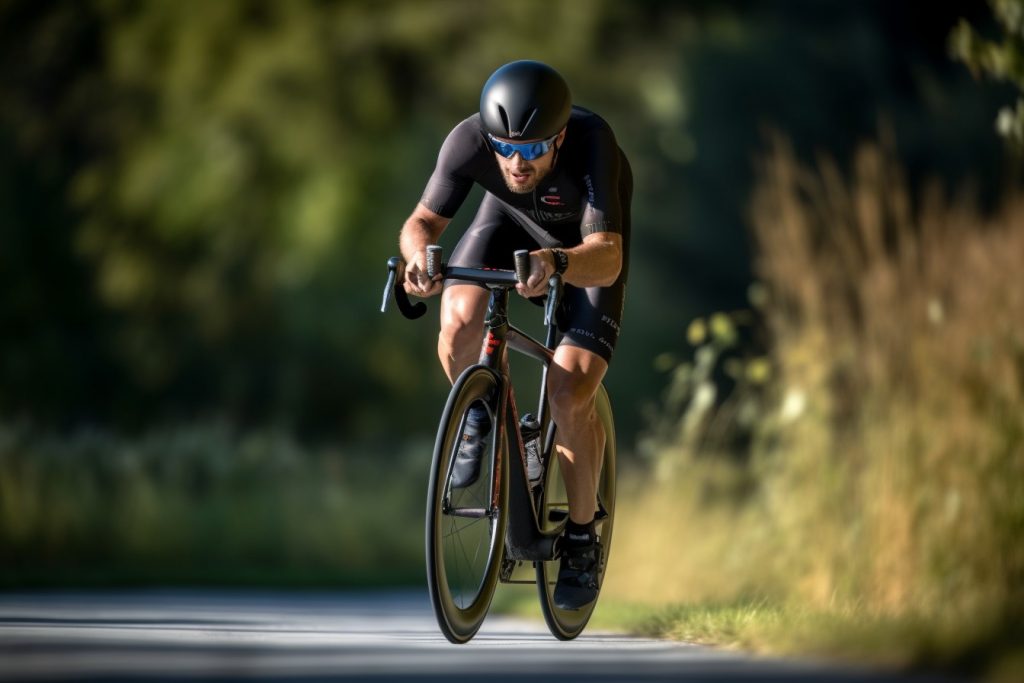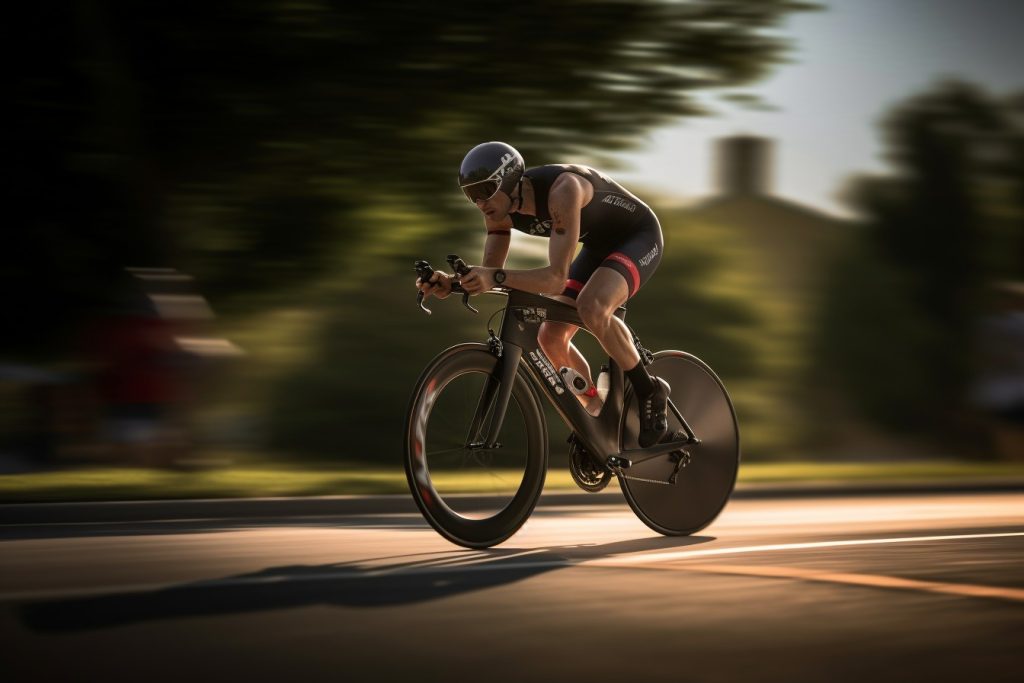Triathlons are a challenging and rewarding experience for athletes of all levels. The combination of swimming, cycling, and running requires a high level of physical fitness and mental toughness. While each discipline is important, cycling is often considered the most crucial part of a triathlon. It is the longest portion of the race and can make or break an athlete’s overall performance. Therefore, improving your cycling speed is essential to achieving success in triathlons. Here are some tips to help you maximize your cycling speed in triathlons.
Firstly, it is important to have the right equipment. Investing in a good quality bike can make a significant difference in your cycling speed. A lightweight bike with aerodynamic features can help you cut through the wind and reduce drag, allowing you to ride faster with less effort. Additionally, having a proper bike fit can also improve your speed and comfort on the bike. A professional bike fitting can ensure that your bike is adjusted to your body’s unique measurements, reducing the risk of injury and improving your efficiency on the bike.
Secondly, training is key to improving your cycling speed. Incorporating interval training into your cycling routine can help you build endurance and increase your speed. Interval training involves alternating between high-intensity efforts and recovery periods. For example, you could do a series of 30-second sprints followed by a minute of recovery, repeating this cycle for several sets. This type of training can help you improve your cardiovascular fitness and increase your lactate threshold, allowing you to ride faster for longer periods.
Thirdly, proper nutrition and hydration are essential for maximizing your cycling speed. Eating a balanced diet that includes carbohydrates, protein, and healthy fats can provide your body with the energy it needs to perform at its best. Additionally, staying hydrated before, during, and after your ride can help you maintain your energy levels and prevent cramping. It is recommended to drink at least 16-20 ounces of water or sports drink per hour of cycling.
Fourthly, improving your cycling technique can also help you increase your speed. Proper pedaling technique involves using a circular motion rather than just pushing down on the pedals. This can help you generate more power and reduce the strain on your muscles. Additionally, maintaining a consistent cadence (the number of pedal revolutions per minute) can help you ride more efficiently. A cadence of 80-100 revolutions per minute is recommended for most cyclists.
Lastly, mental preparation is just as important as physical preparation when it comes to improving your cycling speed in triathlons. Visualizing yourself riding at your desired speed and focusing on your breathing can help you stay calm and focused during the race. Additionally, setting realistic goals and breaking the race into smaller, manageable segments can help you stay motivated and avoid burnout.
In conclusion, improving your cycling speed is essential to achieving success in triathlons. Investing in the right equipment, incorporating interval training into your routine, maintaining proper nutrition and hydration, improving your cycling technique, and mentally preparing yourself for the race can all help you maximize your cycling speed. Remember to start slowly and gradually increase your intensity and distance to avoid injury. With dedication and hard work, you can improve your cycling speed and achieve your triathlon goals.

Effective Training Techniques for Improving Your Cycling Pace
Triathlons are a challenging and rewarding experience for athletes of all levels. However, one of the most important aspects of a triathlon is the cycling portion. Improving your cycling speed can make a significant difference in your overall performance. Here are some effective training techniques for improving your cycling pace.
Firstly, interval training is a great way to improve your cycling speed. This involves alternating between high-intensity efforts and periods of rest or lower intensity. For example, you could do a 30-second sprint followed by a 30-second rest period, and repeat this cycle for a set amount of time. This type of training helps to increase your cardiovascular fitness and build endurance, which can translate into faster cycling times.
Another effective training technique is hill repeats. Find a hill with a challenging gradient and ride up it repeatedly, taking a short rest period at the bottom before starting again. This type of training helps to build leg strength and power, which can improve your ability to climb hills and maintain a faster pace on flat terrain.
In addition to interval training and hill repeats, incorporating strength training into your routine can also help to improve your cycling speed. Exercises such as squats, lunges, and deadlifts can help to build leg strength and power, which can translate into faster cycling times. It is important to focus on proper form and technique when performing these exercises to avoid injury.
Another important aspect of improving your cycling speed is proper nutrition and hydration. Make sure to fuel your body with the right nutrients before and during your training sessions. This can include carbohydrates for energy, protein for muscle repair and recovery, and healthy fats for sustained energy. Hydration is also crucial for optimal performance, so make sure to drink plenty of water before, during, and after your training sessions.
Finally, it is important to incorporate rest and recovery into your training routine. Overtraining can lead to injury and burnout, which can hinder your progress. Make sure to take rest days and allow your body time to recover between training sessions. This can include stretching, foam rolling, and other recovery techniques to help reduce muscle soreness and improve flexibility.
In conclusion, improving your cycling speed in triathlons requires a combination of effective training techniques, proper nutrition and hydration, and rest and recovery. Interval training, hill repeats, and strength training can all help to build leg strength and endurance, which can translate into faster cycling times. Proper nutrition and hydration are also crucial for optimal performance, and rest and recovery are important to avoid injury and burnout. By incorporating these tips into your training routine, you can improve your cycling speed and achieve your triathlon goals.

Strategies for Maintaining a Consistent Cycling Speed in Triathlons
Triathlons are a grueling test of endurance, requiring participants to swim, bike, and run for long distances. While each leg of the race presents its own unique challenges, the cycling portion is often the most critical. Maintaining a consistent cycling speed is essential for success in a triathlon, as it can help conserve energy and ensure that you have enough left in the tank for the run. In this article, we’ll explore some tips for improving your cycling speed in triathlons.
One of the most important strategies for maintaining a consistent cycling speed is to focus on your cadence. Cadence refers to the number of revolutions per minute (RPM) that your pedals make. A higher cadence generally means a faster speed, but it also requires more energy. Finding the right balance between cadence and energy expenditure is key. Many experienced triathletes recommend aiming for a cadence of around 90 RPM, but this can vary depending on your fitness level and the terrain.
Another important factor to consider when trying to improve your cycling speed is your body position on the bike. A more aerodynamic position can help reduce wind resistance and improve your speed. This means keeping your body low and your elbows tucked in, as well as using aero bars if you have them. However, it’s important to find a position that is comfortable for you and doesn’t put too much strain on your back or neck.
In addition to focusing on your cadence and body position, it’s also important to pay attention to your gear selection. Choosing the right gear can help you maintain a consistent speed and conserve energy. Generally, you should aim to use a gear that allows you to maintain a cadence of around 90 RPM without putting too much strain on your legs. This may mean shifting gears frequently as you encounter changes in terrain or wind resistance.
Another key strategy for improving your cycling speed in triathlons is to practice pacing. Pacing refers to the art of maintaining a consistent speed throughout the race, rather than starting out too fast and burning out before the finish line. This can be especially challenging in a triathlon, where you may be tempted to push yourself too hard in the cycling portion in order to gain an advantage. However, it’s important to remember that the race is a marathon, not a sprint. By pacing yourself and maintaining a consistent speed, you’ll be able to conserve energy and ensure that you have enough left in the tank for the run.
Finally, it’s important to remember that improving your cycling speed in triathlons takes time and practice. Don’t expect to see immediate results overnight. Instead, focus on making small improvements over time, such as increasing your cadence or practicing pacing. By consistently working to improve your cycling speed, you’ll be able to achieve your goals and become a stronger, more successful triathlete.
In conclusion, maintaining a consistent cycling speed is essential for success in a triathlon. By focusing on your cadence, body position, gear selection, pacing, and consistent practice, you can improve your cycling speed and become a stronger, more successful triathlete. Remember to be patient and persistent, and don’t be afraid to seek out advice and guidance from experienced triathletes or coaches. With hard work and dedication, you can achieve your goals and become a true champion in the world of triathlon.

Q&A
1. What is the best way to improve cycling speed in triathlons?
The best way to improve cycling speed in triathlons is to focus on building endurance through consistent training, incorporating interval and hill workouts, and optimizing your bike fit and equipment.
2. How can interval training help improve cycling speed?
Interval training involves alternating periods of high-intensity effort with periods of rest or lower intensity. This type of training can help improve cycling speed by increasing your cardiovascular fitness, building muscular endurance, and improving your ability to sustain high-intensity efforts for longer periods of time.
3. What are some tips for optimizing bike fit and equipment to improve cycling speed?
To optimize your bike fit and equipment for improved cycling speed, consider getting a professional bike fitting, investing in a high-quality bike with aerodynamic features, using clipless pedals and cycling shoes for better power transfer, and ensuring that your bike is properly maintained and tuned for optimal performance.Conclusion: Improving cycling speed in triathlons requires a combination of physical training, proper equipment, and strategic race tactics. By incorporating interval training, hill repeats, and strength training into your cycling routine, you can increase your power and endurance on the bike. Investing in a quality bike and gear, such as aerodynamic wheels and aero bars, can also help improve your speed. Finally, practicing race tactics, such as drafting and pacing, can give you an edge on race day. With dedication and hard work, you can improve your cycling speed and achieve your triathlon goals.


Leave a Reply